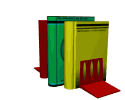Calorie Counter Books

A book is best if you want portability at low cost. It won't do any math for you, however, and may be awkward
when you're dining out. (Use a handheld device
and people will think you're just checking your e-mail.)
 Poor
Poor
 Fair
Fair
 Good
Good
 Outstanding
Outstanding
What These Books Have in Common
All report the calorie content of generic and brand-name foods. Most show other nutrients, too. All are paperbacks small enough to fit into a large breast-pocket or a small purse. All can be purchased from many online stores. (We've cited just one or two major sellers for each, chosen at random. Sellers have not paid for listings.)
How They Differ
Some books cover more foods and nutrients than others. Some are better organized. Some are more compact.
The Complete Book of Food Counts 
By Corinne T. Netzer
6th Edtition, © 2003. Dell. Paperback, 911 pages. 1.6 x 6.9 x 4.3"
Netzer's book shows seven nutrients (calories, carbohydrates, cholesterol, sodium, protein, fat, and fiber) in 18,000 foods, including generic, brand-name, fast-food, chain-restaurant, ethnic, and health foods—all arranged alphabetically by name. Reviewers at amazon.com give it high marks for convenience (it fits easily into a purse) and completeness ("I haven't yet looked for an item that wasn't there"). Some wish it were more consistent in citing portion sizes (one brand may use cup measure, while another lists the same food in ounces) and naming foods ("Why is a red bell pepper listed as 'Pepper, sweet,' while a green bean is listed as a 'Green Bean?'"). The author has published 49 books, most of them nutrition guides. $7.99 at amazon.com.
Doctor's Pocket Calorie, Fat & Carb Counter 
By Allan Borushek
© 2004. Family Health Pubs. Paperback, 302 pages, 0.6 x 5.9 x 4.3"
The author, a dietitian and biochemist, is founder and CEO of CalorieKing, an Australian company that also publishes calorie-counting software and online diet tools. This pocket-size book lists ten nutrients (calories, fat, carbohydrates, protein, cholesterol, calcium, alcohol, fiber, iron, and sodium) in 11,000 foods, including those from 170 restaurant chains. Although the publisher calls this "America's biggest-ever compilation," The Complete Book of Food Counts (above) is larger. The publisher claims to have sold 10 million copies, making the book a Top 100 Bestseller and "the most recommended book of its type by doctors and dietitians." It also includes a Diabetes Diet Guide. Reviewers at amazon.com praise its thoroughness, organization, and compactness (it's an inch shorter than most other books of its type). $7.00 at calorieking.com, $6.99 at amazon.com.
The Calorie Counter 
By Annette B. Natow and Jo-Ann Heslin
3rd ed., © 2003. Pocket Books. Paperback, 656 pages, 1.1 x 6.8 x 4.2"
"If you eat it, you'll find it here," says the book's subtitle. The authors have published 30 books on nutrition, including two college textbooks, and are co-editors of the Journal of Nutrition for the Elderly. Both are former faculty members of Adelphi University and the State University of New York. The Calorie Counter shows calories (but no other nutrients) in more than 20,000 foods, including 90 restaurant chains and thousands of organic and vegetarian foods, plus takeout and international foods, diet and energy bars, and sports drinks. Some reviewers fault it for listing too few generic foods. $6.99 at barnesandnoble.com.
The Ultimate Calorie Counter 
By Sheila Buff
© 2002. St. Martin's Press. Paperback, 211 pages, 0.6 x 6.9 x 4.1"
This standard-size paperback shows six nutrients (calories, fats, protein, cholesterol, carbohydrates, and sugar) in more than 2500 foods, including diet brands such as Jenny Craig and Slim-Fast, as well as fast foods. The first 88 pages explain what a calorie is, how to estimate the number of calories you need, how to burn off calories through exercise, the role of calories in popular diets, and how to eat more food without eating more calories. Unfortunately, these chapters take up nearly half the book, leaving room for a disappointingly short food list. (The average supermarket contains 30,000 foods; the USDA's list of generic foods, 7000.) You will often eat foods that you can't find in this book. $4.99 at amazon.com, $5.99 at booksamillion.com.
Comments? Corrections? .

